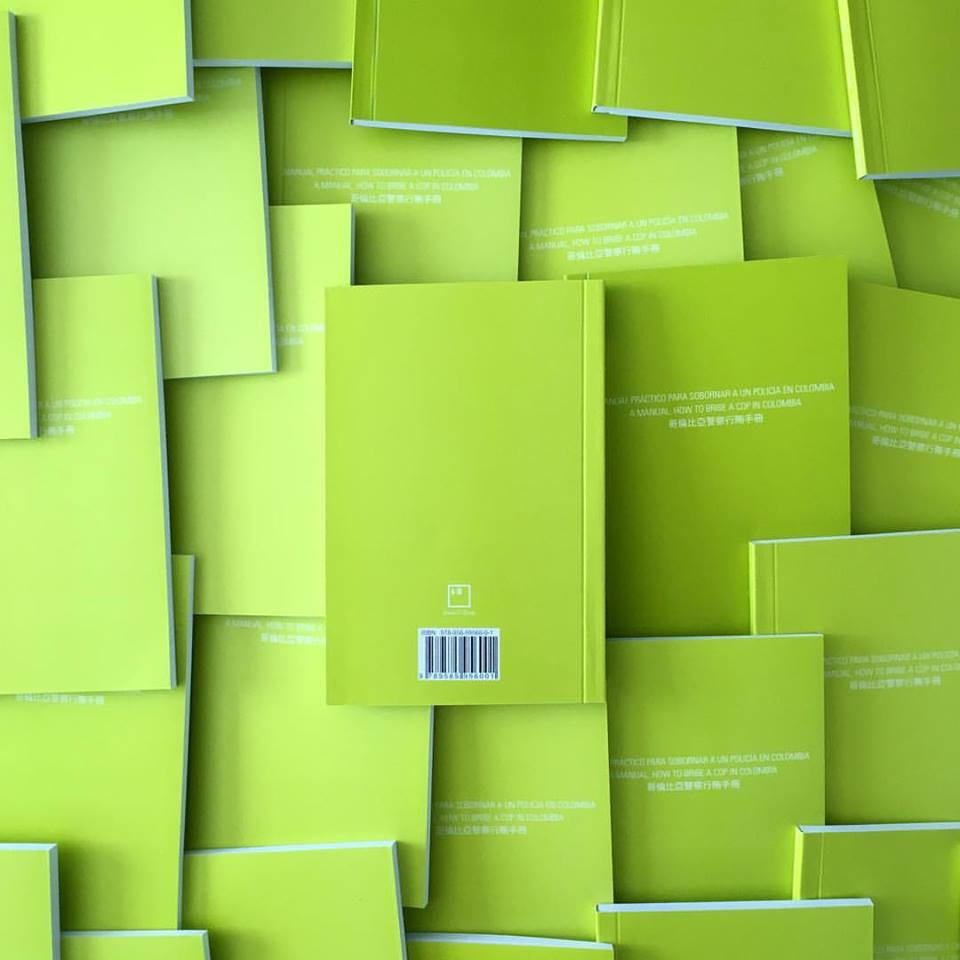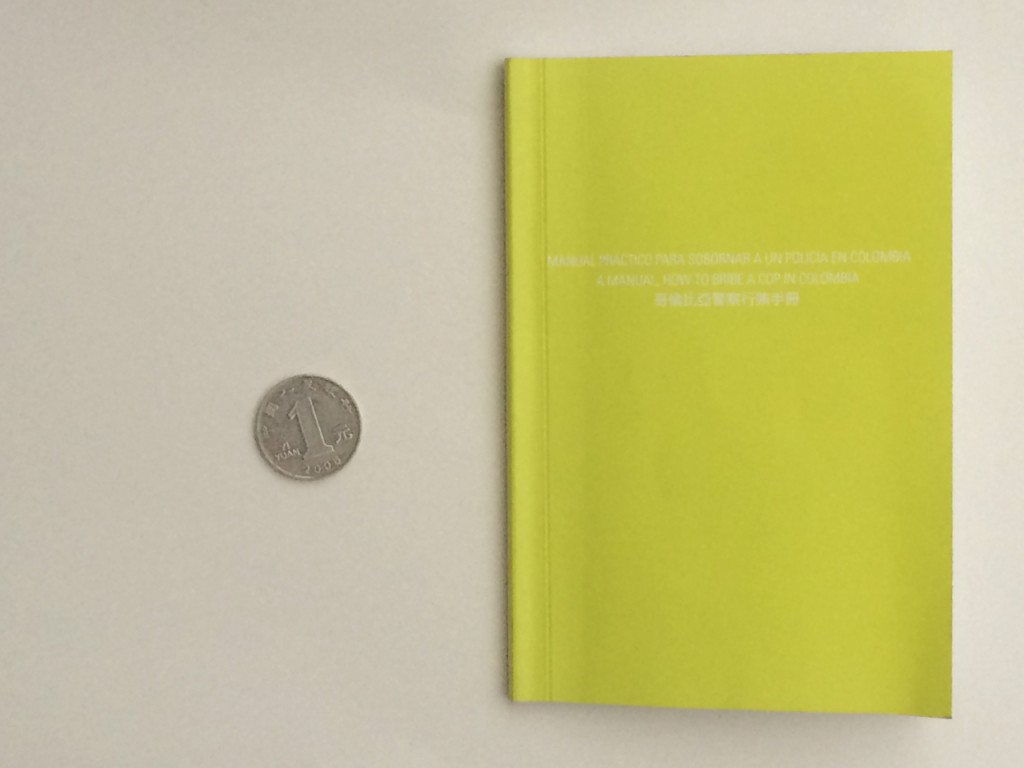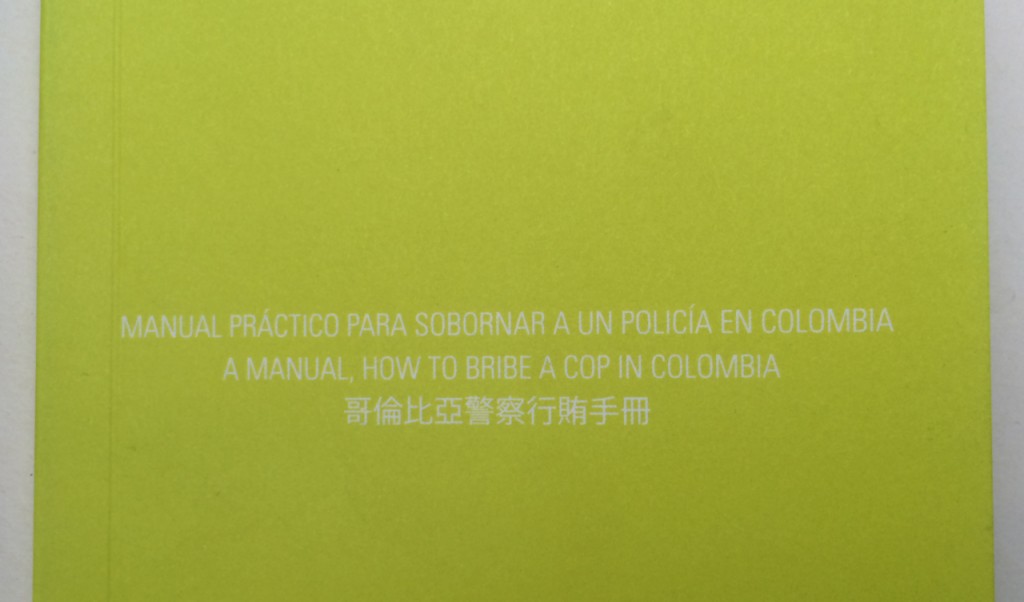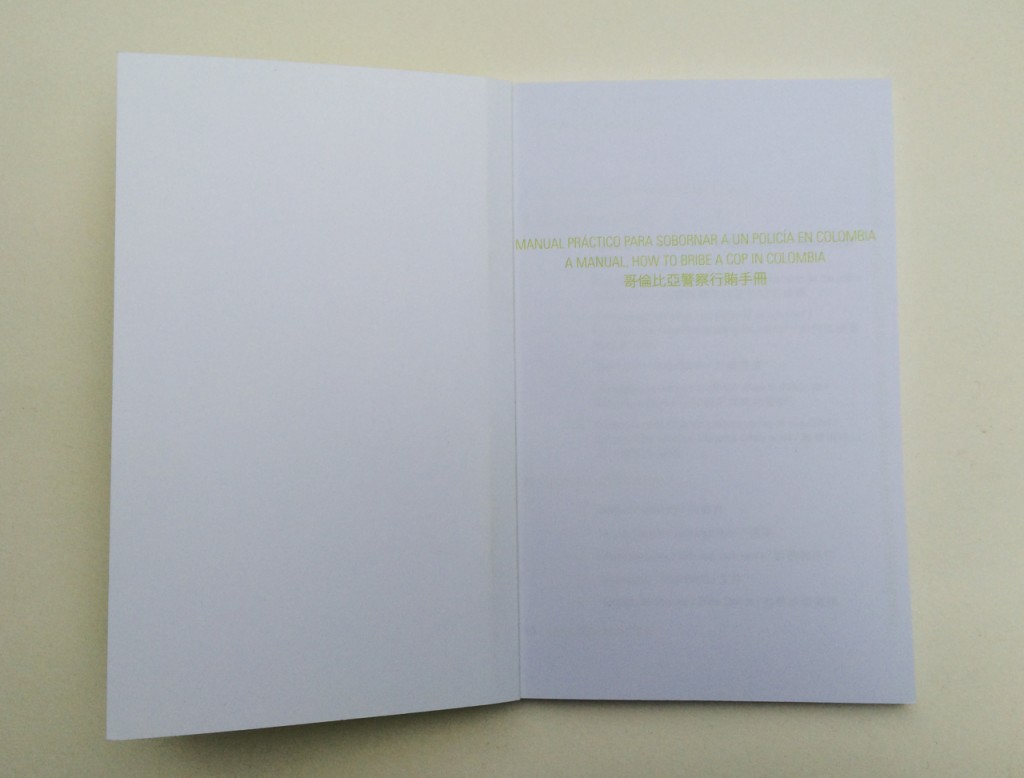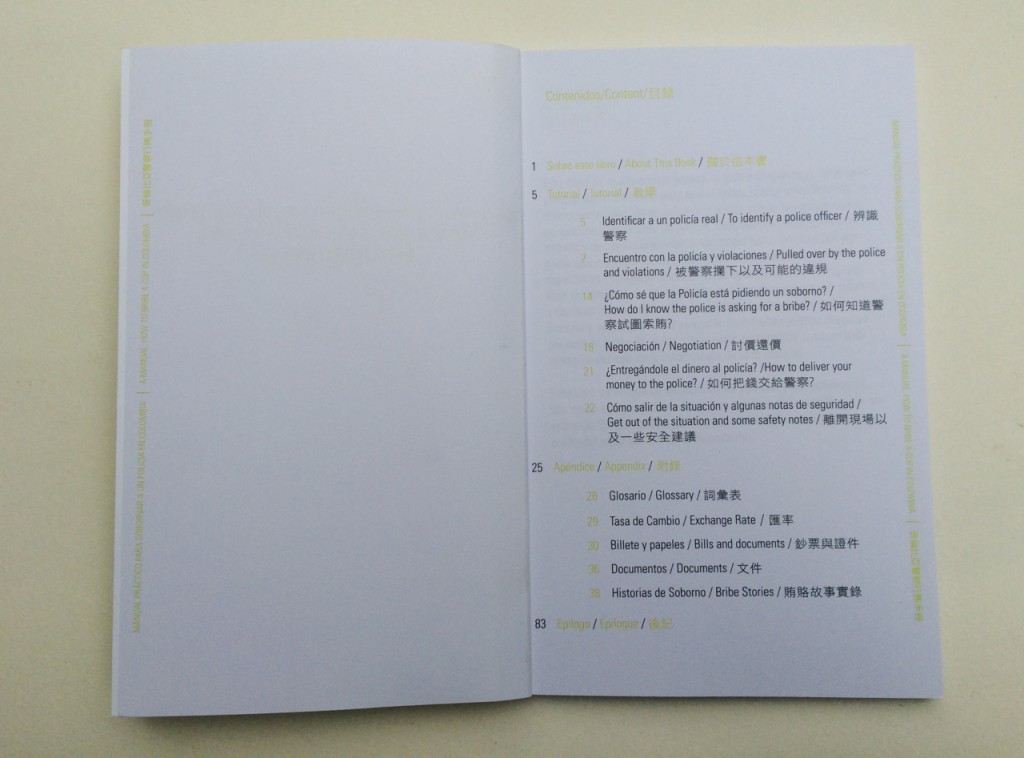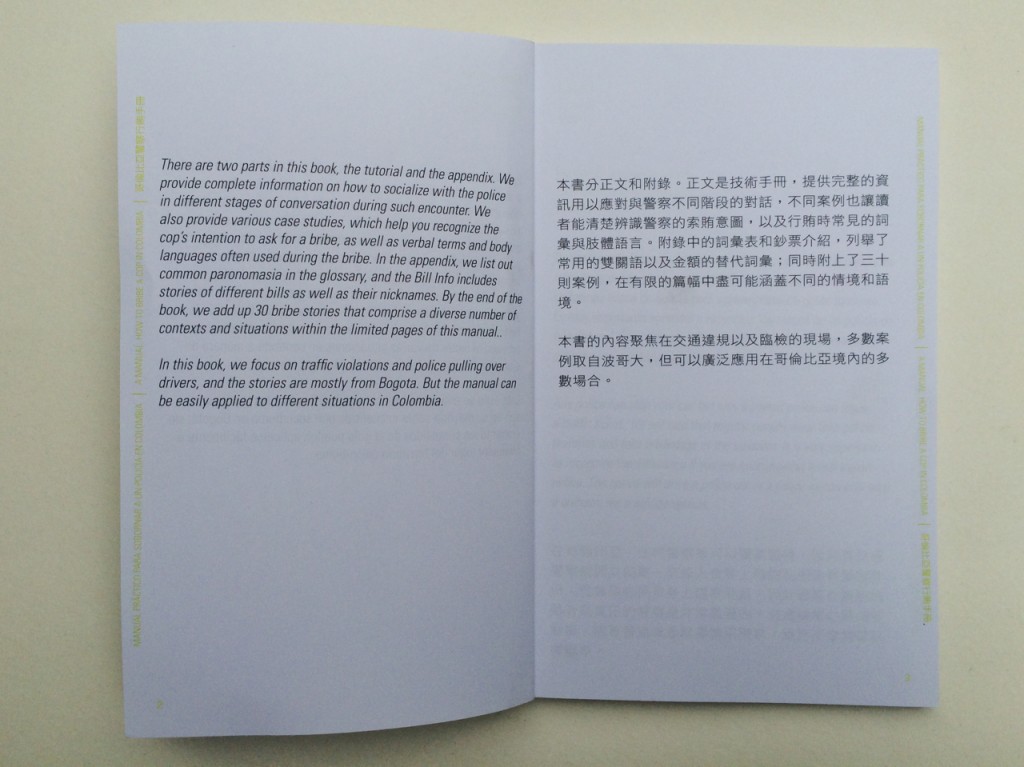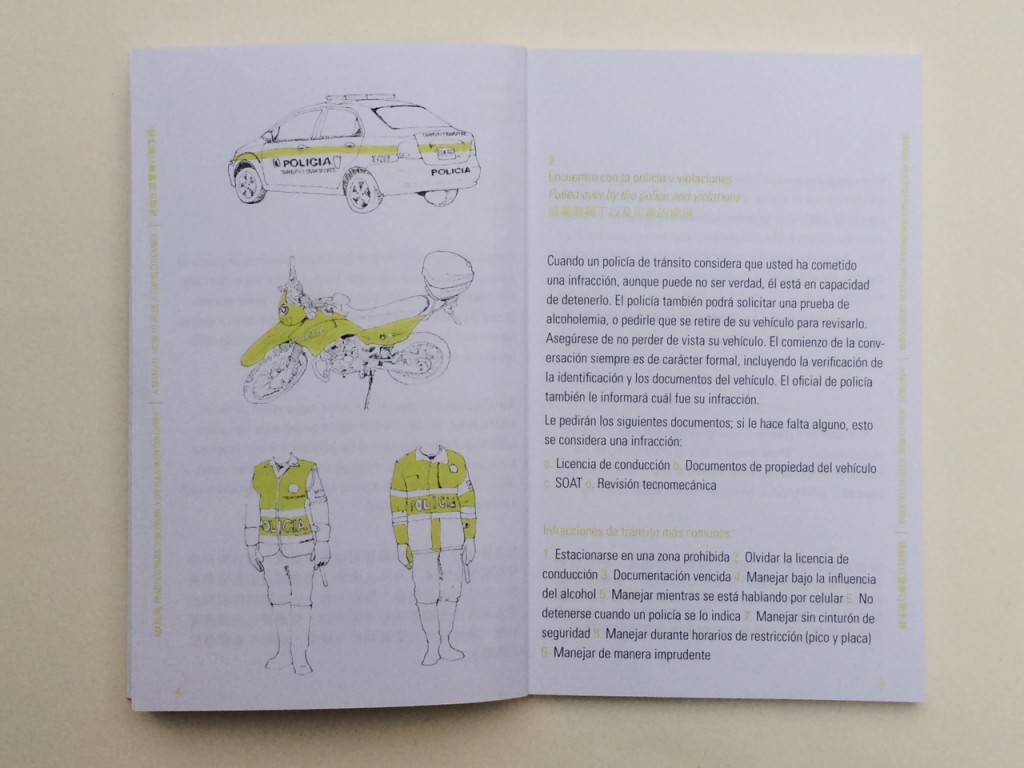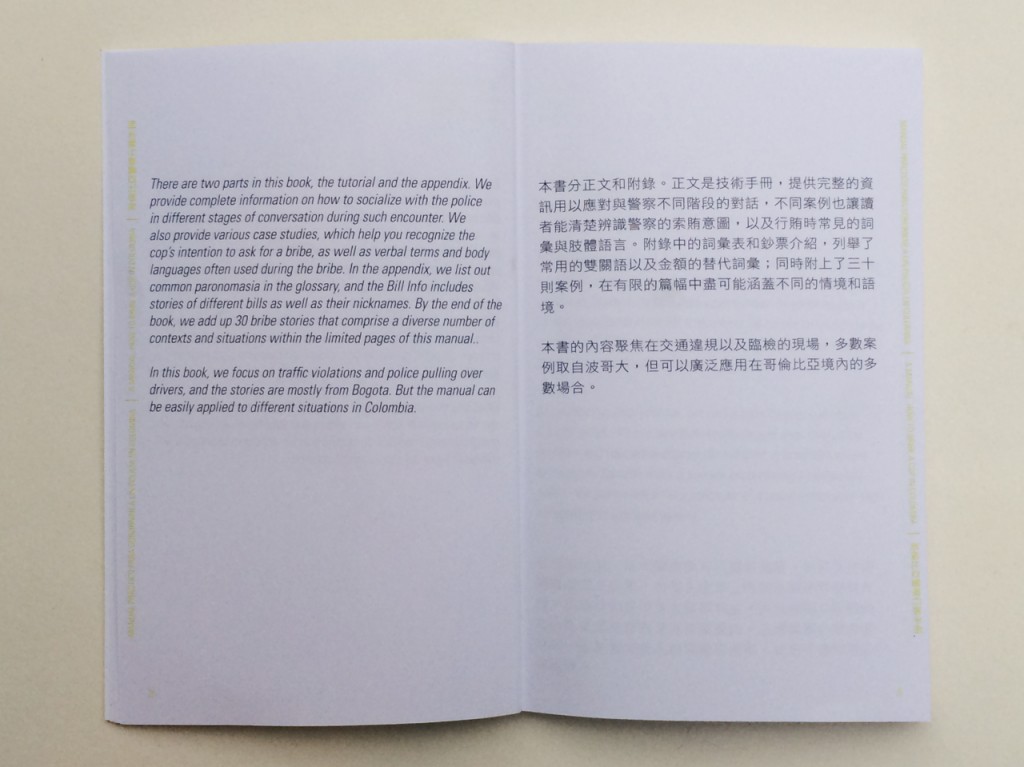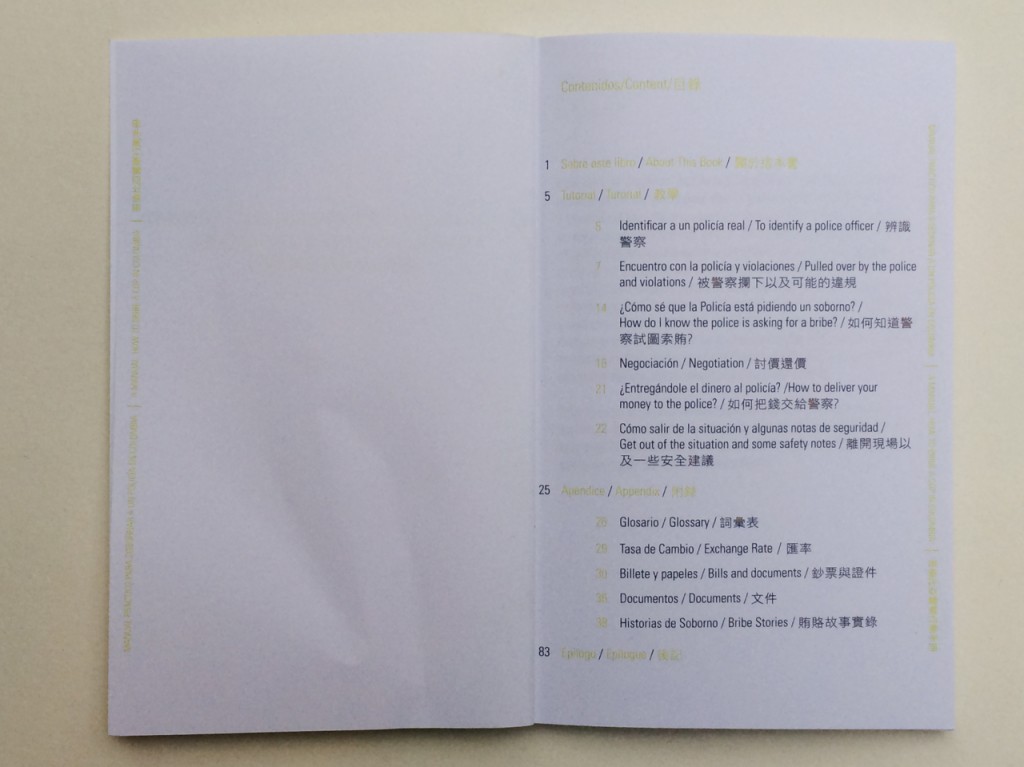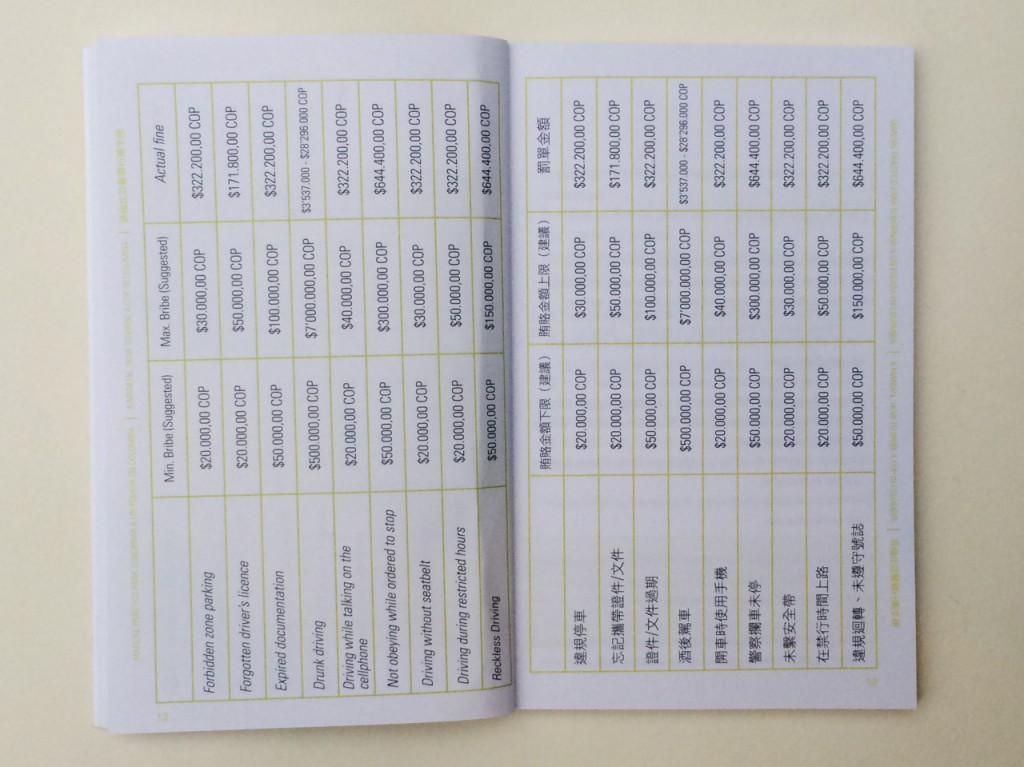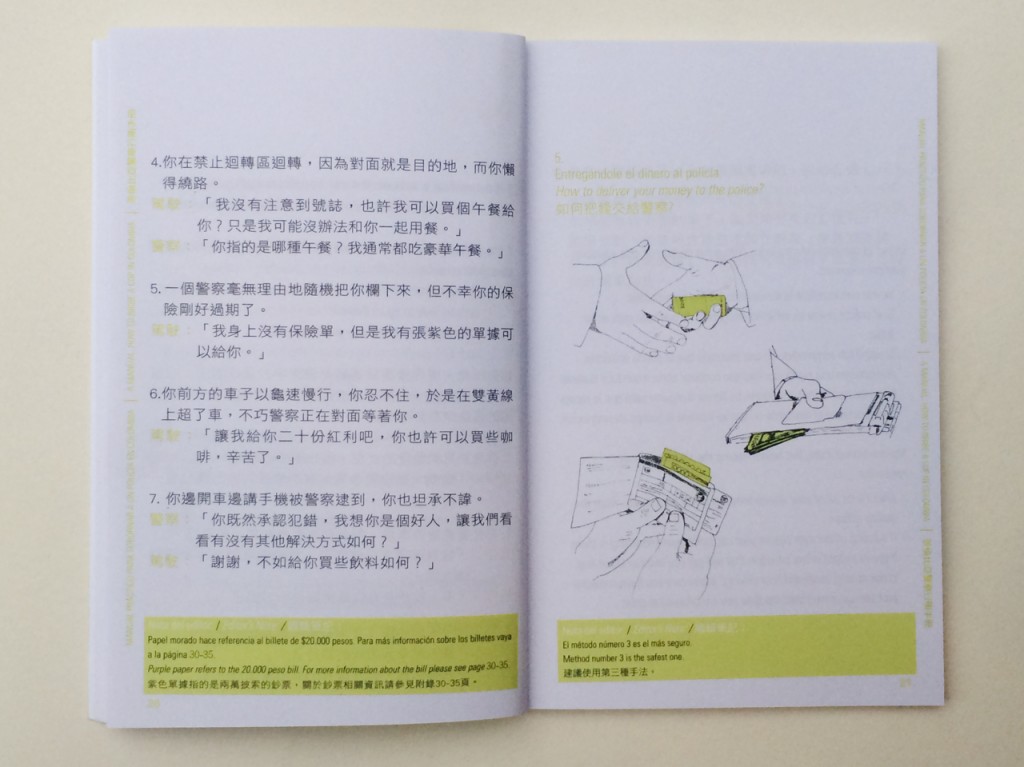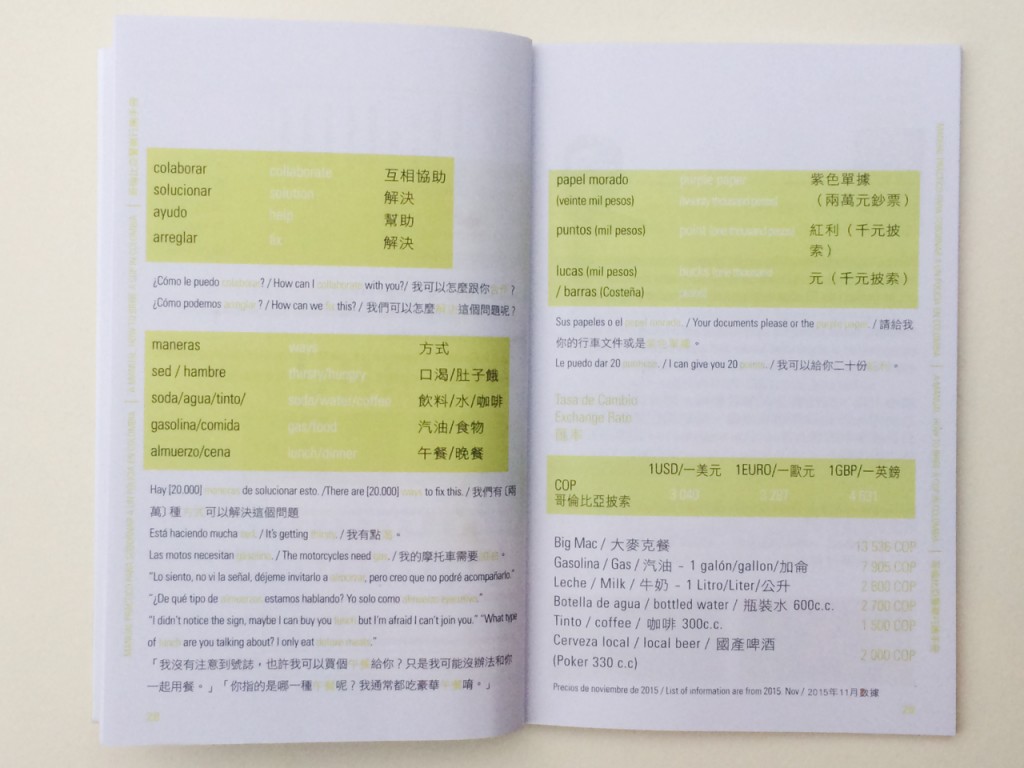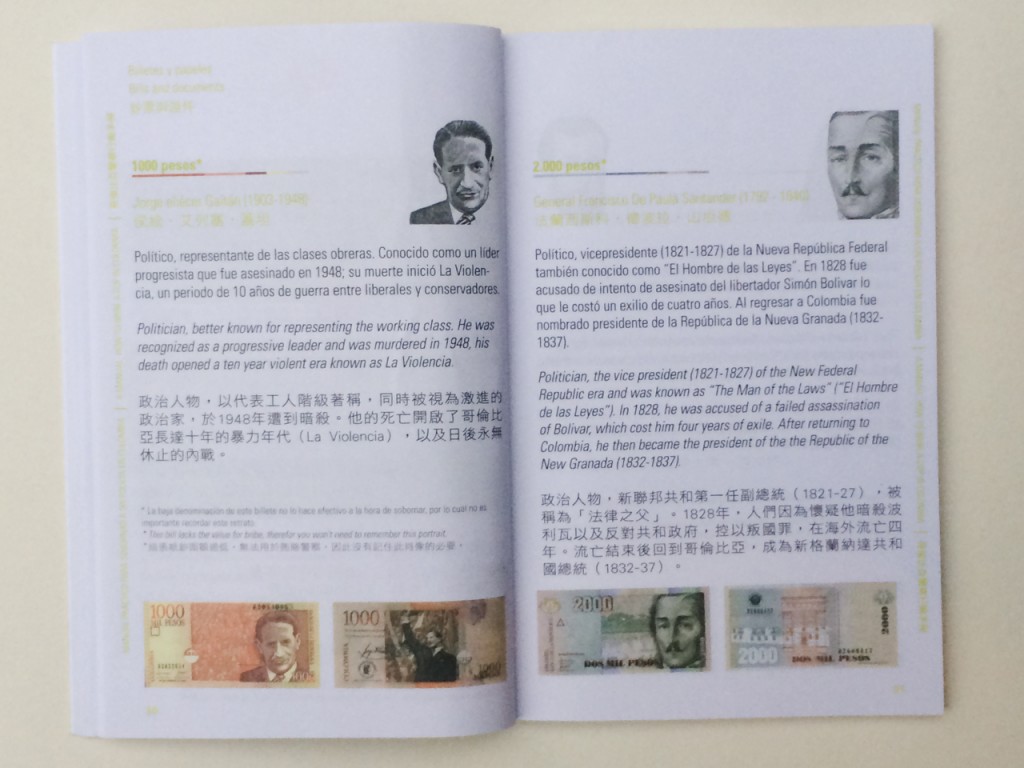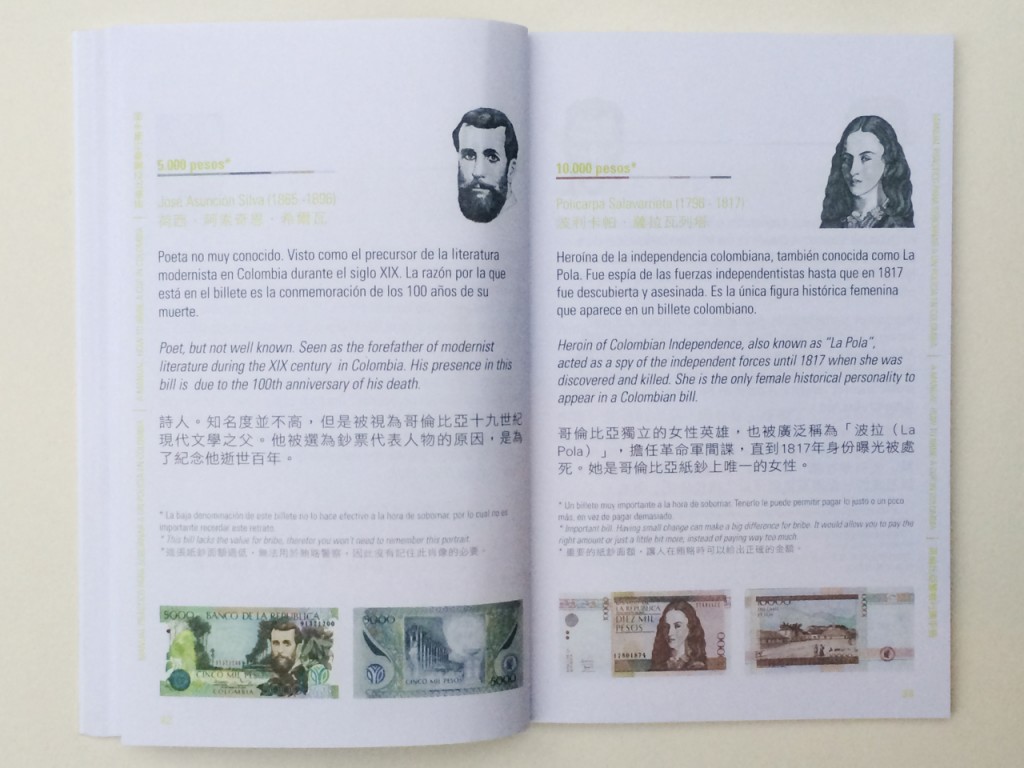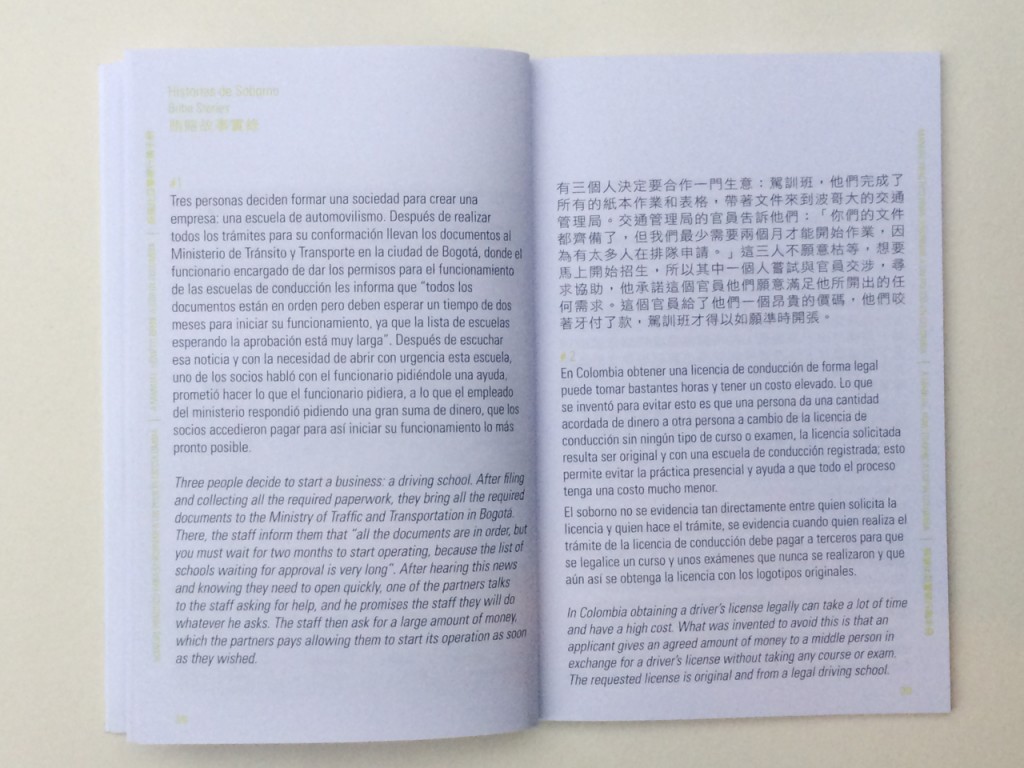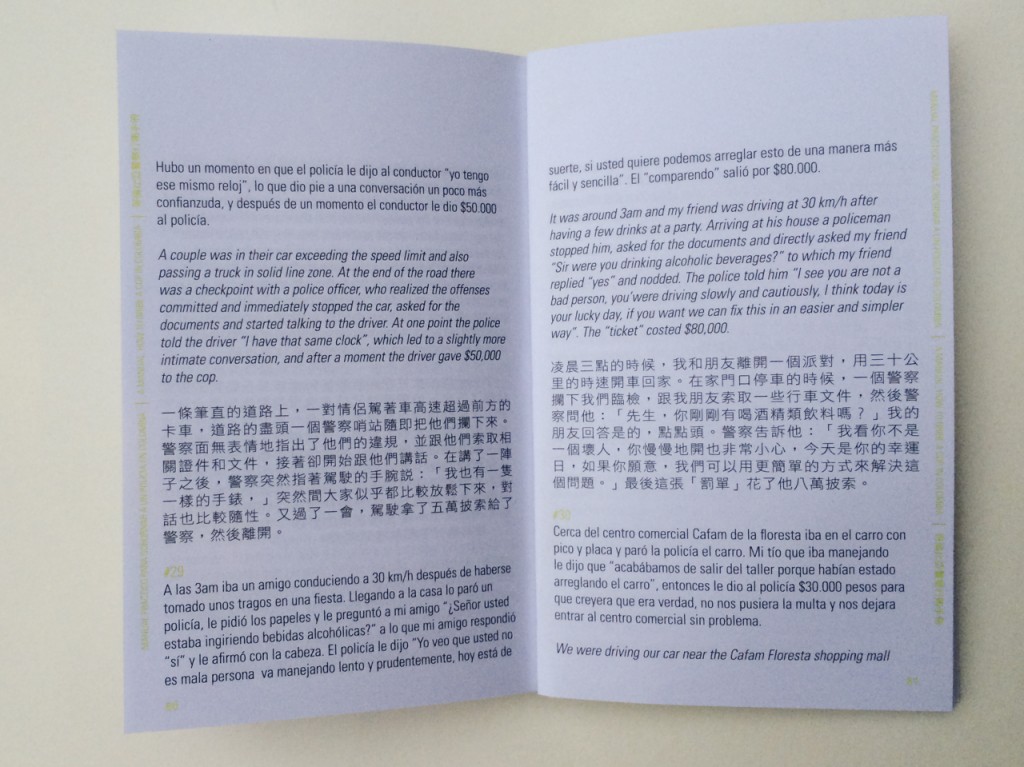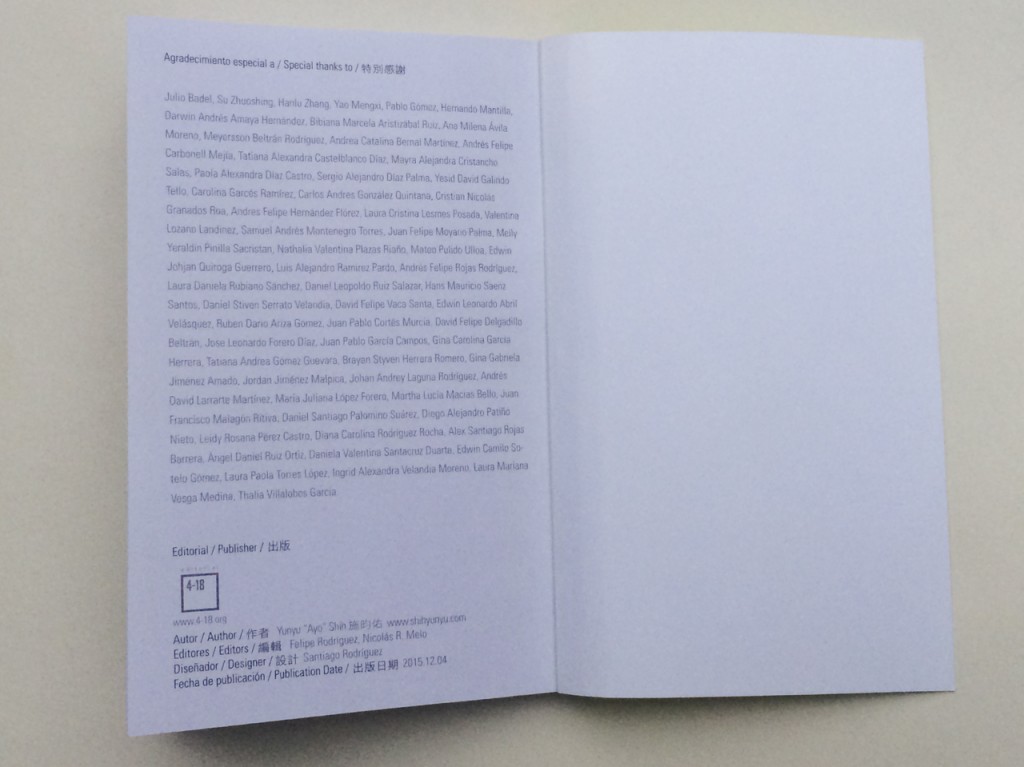Manual Práctico Para Sobornar A Un Polícia En Colombia
A Manual, How to Bribe A Cop in Colombia
哥倫比亞警察行賄手冊
Editorial / Publisher / 出版
4-18.org
Autor / Author / 作者
Yunyu “Ayo” Shih 施昀佑 www.shihyunyu.com
Editores / Editors / 編輯
Felipe Rodríguez, Nicolás R. Melo
Diseñador / Designer / 設計
Santiago Rodríguez
Fecha de publicación / Publication Date / 出版日期
2015.12.04 (Artist Print) / 2016.08.22 (Official Publication Date in Colombia)
Sobre este libro / About This Book / 關於這本書
Este libro se divide en dos partes: la guía y el apéndice. En la guía proveemos información para que el lector pueda identificar las diferentes etapas de un soborno y pueda actuar adecuadamente en caso de encontrarse un policía. También presentamos varios estudios de caso que ayudan a reconocer tanto la intención por parte de un policía de ser sobornado, como ciertos términos específicos y lenguaje corporal. En el apéndice proponemos una lista de términos de doble sentido que son comunes en un soborno, y también información sobre los billetes usados en Colombia (su historia y apodos). Al final se encuentran treinta testimonios que proveen al lector de varias situaciones en contexto a manera de ejemplos del uso de la información de este manual.
Este libro se enfoca en violaciones de tránsito y los testimonios son en su mayoría sobre encuentros que sucedieron en Bogotá; sin embargo los contenidos de la guía pueden aplicarse fácilmente a cualquier lugar del territorio colombiano.
#
In 2015, I was visiting Colombia as a resident artist for the 4-18 program. During my time staying there, the communication with police brought me a certain degree of inconvenient. Therefor, I decided to made a guide for tourist and visitors, a book about how to bribe a cop in Colombia. I proposed my idea and received great help from 4-18, local artist and Bogota Technology University. We made online and paper survey, with interview in person. In the end, we collect more than 600 on-line survey, 200 written survey and 150 interviews. After six months hard working, we publish this book.
There are two parts in this book, the tutorial and the appendix. We provide complete information on how to socialise with the police in different stages of conversation during such encounter. We also provide various case studies, which help you recognise the cop’s intention to bribe, as well as verbal terms and body languages often used during the bribe. In appendix, we list out common paronomasia in the glossary, and the Bill Info includes stories of different bills as well as their nicknames. By the end of the book, we add up 30 bribe stories that comprise as diverse context and situation as possible within the very limited pages.
In this book, we focus on traffic violation and police pulled-over, and the stories are mostly from Bogota. But the manual can be easily applied to different situation in Colombia.
#
2015年藝術家到南美洲的哥倫比亞,因為和警察溝通而產生了諸多生活上的不便,因此決定與當地藝術家和駐村藝術機構,聯合波歌大科技大學,共同編寫一份給旅行者的哥倫比亞警察行賄手冊。我們共同製作了網路與紙本問卷,並同時進行深度訪談,回收了超過六百份網路問卷、兩百則有效的紙本訪談以及一百五十筆深度訪談,經過半年的統整與編寫,完成了這份手冊。
本書分正文和附錄。正文是技術手冊,提供完整的資訊用以應對與警察不同階段的對話,不同案例也讓讀者能清楚辨識警察的索賄意圖,以及行賄時常見的詞彙與肢體語言。附錄中的詞彙表和鈔票介紹,列舉了常用的雙關語以及金額的替代詞彙;同時附上了三十則案例,在有限的篇幅中儘可能涵蓋不同的情境和語境。
本書的內容聚焦在交通違規以及臨檢的現場,多數案例取自波哥大,但可以廣泛應用在哥倫比亞境內的多數場合。
Epílogo/Epilogue/後記
Este libro surge luego de mi experiencia visitando Colombia en marzo del 2015. Entre marzo y octubre gracias a la gran ayuda de 4-18 pudimos recolectar 130 testimonios confirmados y mas de 200 encuestas con datos estadísticos sobre el soborno; también recolectamos testimonios de manera informal cenando y tomando café. En base a esta información pudimos terminar este libro.
Mientras editaba este libro dos cosas me impactaron: por un lado me sentí como en casa, donde la burocracia abunda en el diario vivir y una gran cantidad de interacciones humanas suceden en áreas grises e indefinidas; por otro lado fue muy entretenido encontrarme con la inmensa creatividad de la gente para ampliar las posibilidades del lenguaje y contexto. Todos hemos sido testigos del uso de dobles lenguajes por parte de nuestros padres a la hora de negociar en el asiento del conductor, en oficinas gubernamentales o en lugares similares y, nos guste o no, esas experiencias se convierten de forma inevitable en parte de nuestro ser y de nuestra memoria corporal. Pienso que hacer este libro es de alguna forma construir una memoria que recoge todas estas experiencias colectivas.
Espero que este libro funcione como un manual práctico, o quizá como un regalo a un amigo o a un hijo que acaba de tramitar su licencia de conducción, o incluso, puede volverse una decoración en las paredes de su hogar ya que este libro es también en un proyecto artístico hecho por un artista, y en ese sentido puede que no necesite volver a abrirse nunca más.
Agradecimientos especiales a Felipe Rodríguez y a Nicolás Melo de 4-18, sin su ayuda me habría sido imposible cruzar la barrera del lenguaje. Gracias también a Santiago Rodríguez, quién superó la falta de familiaridad con los carácteres chinos en tan corto tiempo para lograr un gran diseño editorial.
#
This book is a proposal I made after I visited Colombia on March, 2015. From March to October, with tremendous help from 4-18, we receive one hundred and thirty valid stories and more than two hundred statistics about police bribe. We also collected many stories while drinking coffee or dining with friends. Based on that information, we finally finished this book.
While editing this book, I often felt like being at home: bureaucracy everywhere in daily life, with enormous uncertain vague areas ruled by man; also, I was often entertained by people’s creativity, in which they extend the possibilities of language by responding to specific contexts in everyday life. We’ve all been a witness while our parents use vague terms to negotiate in their driver’s seat, iin government offices or in any other possible place. Whether we like it or not, those experience violently merged into our body and became part of our memory. I think I’m making this book to build a memorial for those collective memories.
I hope this book will be a practical manual book, or maybe a gift for your friend and kids who just received their driver’s license. What’s more, maybe it will simply be a decoration on your bookshelves, it’s only an art project done by an artist, with no need to open this book again.
Thanks to Felipe Rodriguez and Nicolas Melo from 4-18, without their help, I would never been able to cross the language barrier. Thanks to Santiago Rodriguez, he overcame the unfamiliarity of Chinese font in such a short time and accomplished such a great book design.
#
這本書是我在2015年三月造訪哥倫比亞時提出的創作計畫。透過4-18的協助,我們在七個月的工作時間內取得了一百三十份有效的訪談故事,以及超過兩百份賄賂警察的相關數據。加上無數茶餘飯後閒聊時所蒐集的行賄技巧,終於完成這本書。
在編輯書的過程中,我經常覺得自己好像回到了故鄉:生活中處處是官僚的影子,同時有著無數的灰色和人治地帶;也經常在閱讀過程中被逗得樂不可支,因為人們總能因應生活中的特殊情境,延展語言的可能,進而創造了一個獨特的語言系統。我們都曾目睹自己的父母兄姐在駕駛座上、在政府機關或是任何其他場合用模糊曖昧的語言和公權力周旋,而無論喜愛與否,到了最後,這些經驗都粗暴地成了身體記憶的一部分。我想,這本書正是我為這些記憶所建造的紀念碑。
我的目標是,希望這本書能成為一本實用的旅遊手冊,或是一個贈與朋友或子女取得駕照的禮物,又或者,有一天能成為書架上的裝飾品,只是某個藝術家的創作,再也沒有拿出來使用的必要。
謝謝4-18藝術團隊中FelipeRodriguez和NicolasMelo的協助,沒有他們,我無法跨越語言的障礙完成這本書;也謝謝SantiagoRodriguez,在最短的時間裡熟悉中文字型,完成了傑出的書籍設計。
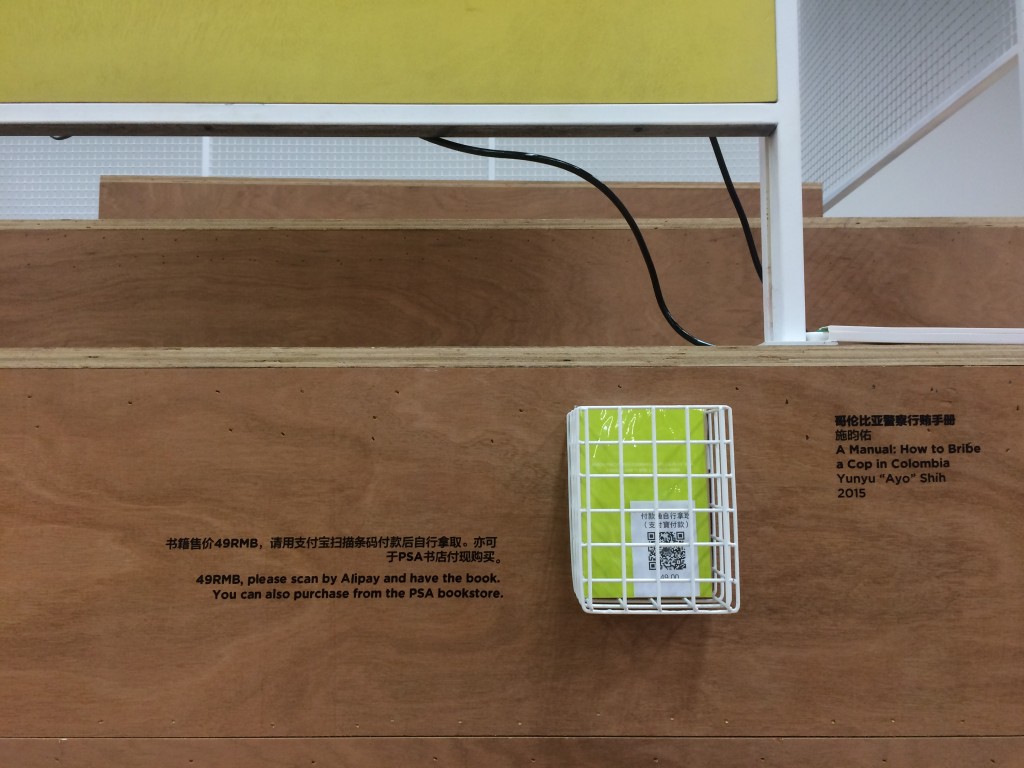
Installation view of “展覽的噩夢(下)”
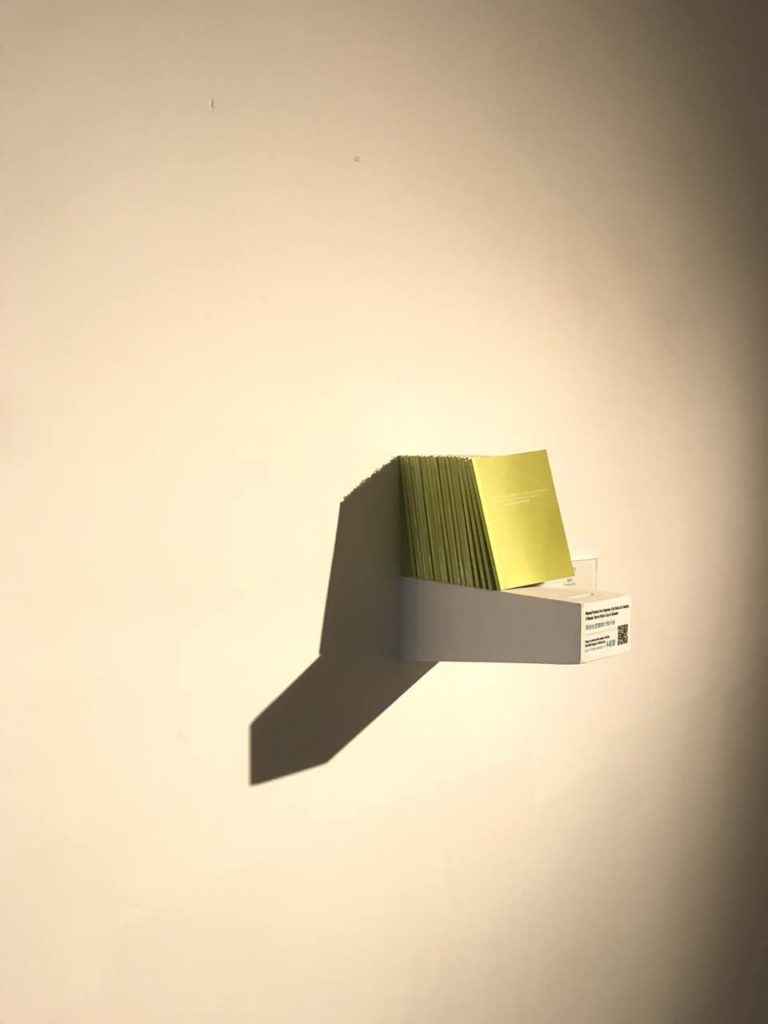
Courtesy to Art Sanya
